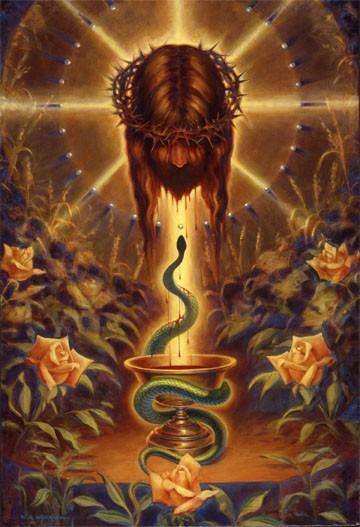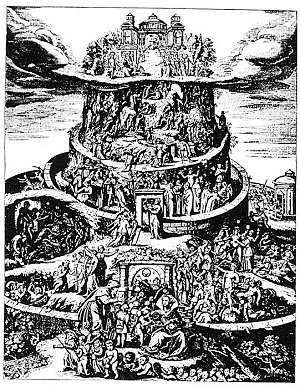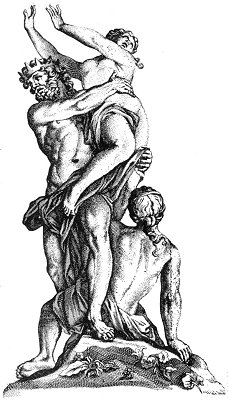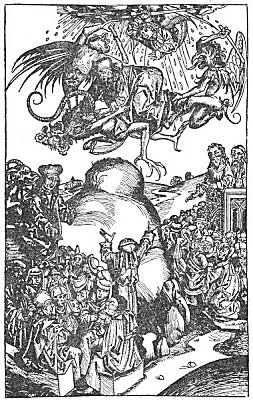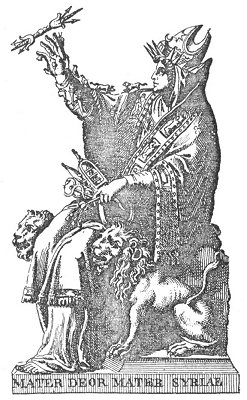When the woman separates herself from her androgyne, and becomes
Page 225
a distinct individuality, the first story is repeated over again. Both the Father and Son, the two Adams, love her beauty; and then follows the allegory of the temptation and fall. It is in the Kabala, as in the Ophite system, in which both the Ophis and the Ophiomorphos are emanations emblematized as serpents, the former representing Eternity, Wisdom, and Spirit (as in the Chaldean Magism of Aspic-worship and Wisdom-Doctrine in the olden times), and the latter Cunning, Envy, and Matter. Both spirit and matter are serpents; and Adam Kadmon becomes the Ophis who tempts himself — man and woman — to taste of the “Tree of Good and Evil,” in order to teach them the mysteries of spiritual wisdom. Light tempts Darkness, and Darkness attracts Light, for Darkness is matter, and “the Highest Light shines not in its Tenebrae.” With knowledge comes the temptation of the Ophiomorphos, and he prevails. The dualism of every existing religion is shown forth by the fall. “I have gotten a man from the Lord,” exclaims Eve, when the Dualism, Cain and Abel — evil and good — is born. “And the Adam knew Hua, his woman (astu), and she became pregnant and bore Kin, and she said: : Kiniti ais Yava. — I have gained or obtained a husband, even Yava — Is, Ais — man.” “Cum arbore peccati Deus creavit seculum.”
And now we will compare this system with that of the Jewish Gnostics — the Nazarenes, as well as with other philosophies.
The ISH AMON, the pleroma, or the boundless circle within which lie “all forms,” is the THOUGHT of the power divine; it works in SILENCE, and suddenly light is begotten by darkness; it is called the SECOND life; and this one produces, or generates the THIRD. This third light is “the FATHER of all things that live,” as EUA is the “mother of all that live.” He is the Creator who calls inert matter into life, through his vivifying spirit, and, therefore, is called the ancient of the world. Abatur is the Father who creates the first Adam, who creates in his turn the second. Abatur opens a gate and walks to the dark water (chaos), and looking down into it, the darkness reflects the image of Himself . . . and lo! a SON is formed — the Logos or Demiurge; Fetahil, who is the builder of the material world, is called into existence. According to the Gnostic dogma, this was the Metatron, the Archangel Gabriel, or messenger of life; or, as the biblical allegory has it, the androgynous Adam-Kadmon again, the SON, who, with his Father’s spirit, produces the ANOINTED, or Adam before his fall.
When Swayambhuva, the “Lord who exists through himself,” feels impelled to manifest himself, he is thus described in the Hindu sacred books.
Having been impelled to produce various beings from his own divine
Page 226
substance, he first manifested the waters which developed within themselves a productive seed.
The seed became a germ bright as gold, blazing like the luminary with a thousand beams; and in that egg he was born himself, in the form of BRAHMA, the great principle of all the beings (Manu, book i., slokas 8, 9).
The Egyptian Kneph, or Chnuphis, Divine Wisdom, represented by a serpent, produces an egg from his mouth, from which issues Phtha. In this case Phtha represents the universal germ, as well as Brahma, who is of the neuter gender, when the final a has a diaresis on it; otherwise it becomes simply one of the names of the Deity. The former was the model of the THREE LIVES of the Nazarenes, as that of the kabalistic “Faces,” PHARAZUPHA, which, in its turn, furnished the model for the Christian Trinity of Irenaeus and his followers. The egg was the primitive matter which served as a material for the building of the visible universe; it contained, as well as the Gnostic Pleroma, the kabalistic Shekinah, the man and wife, the spirit and life, “whose light includes all other lights” or life-spirits. This first manifestation was symbolized by a serpent, which is at first divine wisdom, but, falling into generation, becomes polluted. Phtha is the heavenly man, the Egyptian Adam-Kadmon, or Christ, who, in conjunction with the female Holy Ghost, the ZOE, produces the five elements, air, water, fire, earth, and ether; the latter being a servile copy from the Buddhist A’d, and his five Dhyana Buddhas, as we have shown in the preceding chapter. The Hindu Swayambhuva-Nara, develops from himself the mother-principle, enclosed within his own divine essence — Nari, the immortal Virgin, who, when impregnated by his spirit, becomes Tanmatra, the mother of the five elements — air, water, fire, earth, and ether. Thus may be shown how from the Hindu cosmogony all others proceed.

Moe is the founder of GnosticWarrior.com. He is a father, husband, author, martial arts black belt, and an expert in Gnosticism, the occult, and esotericism.

